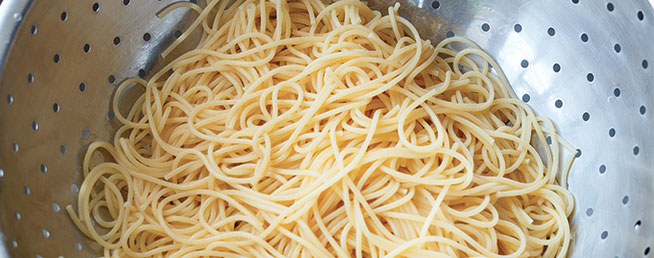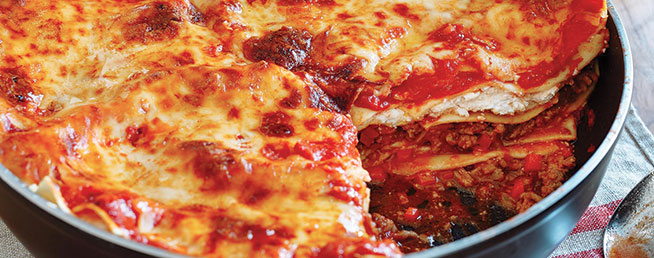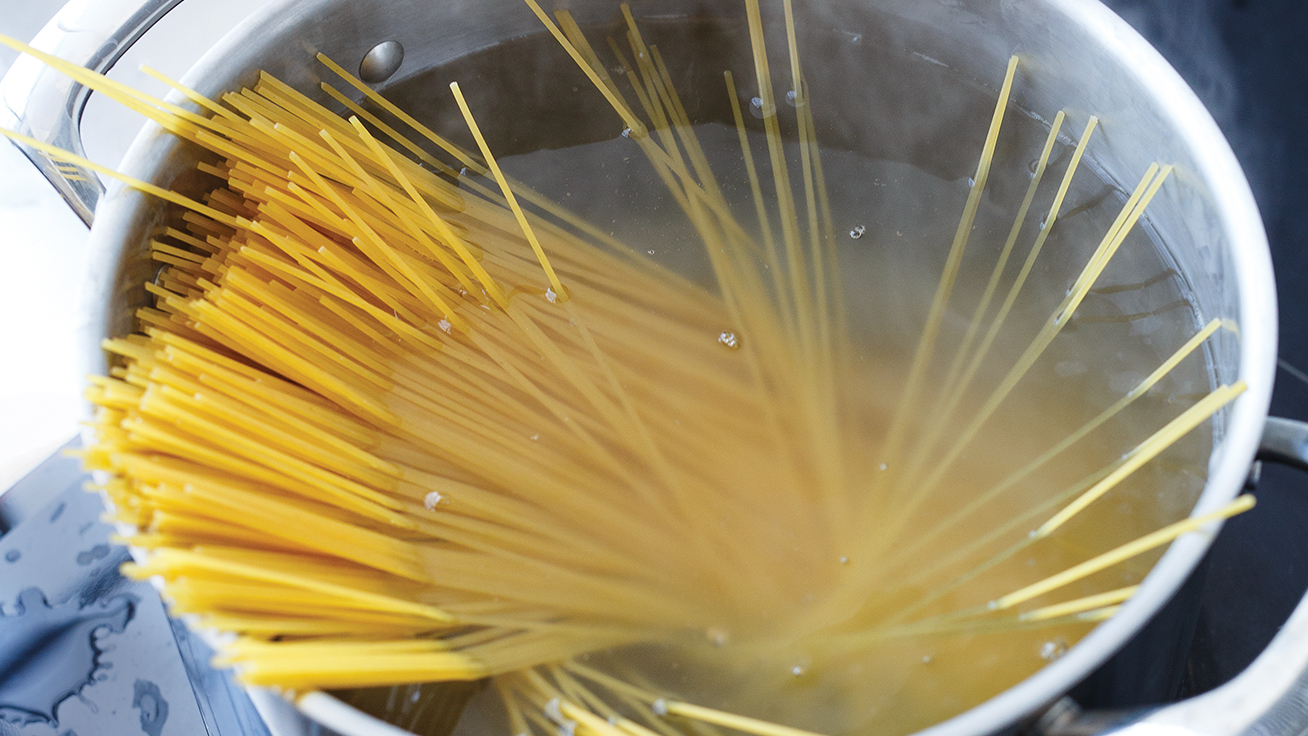Like any good daughter of an Italian mother, I learned how to make fresh pasta at a very young age, and still do it quite often for family celebrations. But, like most people, I rely on the store-bought, dry version the majority of the time I find myself craving pasta at home. It’s made from the aptly named durum (“hard”) wheat (grano duro), which is actually so hard that it can’t be ground into flour very easily. Instead, it’s usually processed into a naturally yellow, granular semolina, which gives dry pasta that warm golden colour. dDurum-wheat semolina is ideal for making pasta, since it retains its firmness and is not very sticky once cooked. Still, sometimes the results are less than magnifico. Here are some tips for cooking perfect pasta every time.
Test the waters
The general rule is that pasta should be cooked in a large pot of boiling water: about 4 cups (1 litre) per 100 grams of pasta. But there’s no need to measure—it’s not as crucial as you might think! According to Harold McGee, a food science expert who explored the issue in 2009 in an article published in The New York Times, not that much water is required. His conclusion? You need just enough to cover the pasta.
Say what? Feeling skeptical, I performed some tests of my own. I put penne in a pot, added just enough cold water to submerge it (plus an extra two or three centimetres to account for expansion during cooking), then brought it all to a boil, stirring occasionally— especially at the beginning—until the pasta was al dente (the centre of the noodle still slightly firm with each bite). I was expecting a pile of sticky pasta, but that wasn’t the case. The penne was simply perfect!
I repeated the experiment using egg noodles. Once again, the result was impeccable. This technique, as McGee rightly states, saves both time and energy. Even pasta manufacturers are starting to follow suit. For example, the Barilla brand recently launched a new Pronto line of pasta, which is cooked precisely in this manner and absorbs only the required amount of water. (The pasta doesn’t even need to be strained!)
Pasta alla... Canada?
The very best durum wheat is produced in our country, thanks to the hot, dry summers in the Prairie provinces. Every year, Canada, the largest exporter in the world, produces enough durum wheat to make four billion 2-lb (900 g) packages of pasta! Canadian wheat is even used in pasta that’s made in Italy and then imported into Canada.

Pass the salt
It’s often said that salt is essential for raising the temperature of water so that pasta will cook more quickly. It’s true that salt will increase the boiling point of water, but the effect is negligible. With the suggested amount (1 to 3 tbsp of salt for a large pot of water), the temperature only rises a mere 0.5° to 1°C. So why bother salting the water? Simply to add flavour to the pasta. In other words, it’s a matter of taste. Those who monitor their sodium intake, for instance, can use less salt—or none at all.
A question of time
You can usually rely on the suggested cooking time listed by the manufacturer on the packaging. All you have to do is stir the pasta several times during the first few minutes of boiling to prevent the noodles from sticking together. Then, in the last few minutes, regularly test the pasta (every 30 seconds or so) until the texture is al dente.
Quality control
But what if, despite these precautions, the result is “pasty”? This might mean a problem with the manufacturing technique. Good-quality pasta, whether Canadian or European, is made from 100% durum-wheat semolina. If some noodles have a thicker consistency than others, this may be due to the quality of the semolina (if, for instance, improper grinding has produced defects) or something to do with the force of extrusion.
Extrusion is the process by which the dough (a lumpy mixture known as the agglomerate) is pushed through a mould to obtain the desired shape (fusilli, macaroni, spaghetti, etc.). If the pressure is not strong enough, the pasta may not hold together properly. Drying conditions (temperature, humidity, speed) also influence the pasta’s texture. In other words, several factors beyond our control can have an impact on the characteristics of the dry pasta we buy at the store.
Strain it
Once the pasta is ready, it must be strained immediately. If you leave it in the hot water, it will continue to cook. Just before pouring the pasta into the colander, you can put a bit of the cooking water in a measuring cup and set it aside. Thanks to the starch it contains, it will help create a beautifully emulsified sauce that thoroughly coats the pasta. You can also use this water to thin out your sauce if it’s getting too thick. Ideally, the pasta should be used immediately once it’s strained because even the very best pasta, cooked to perfection, will start to stick together if it’s left to sit out for too long.
One-pot shot
The One Pot Pasta concept was a viral phenomenon. It involved cooking not only the pasta, but also all the other ingredients, in the same pot. The pasta absorbs the liquid and the remaining ingredients (spices, vegetables, meat) cook and turn tender. Meanwhile, the starch on the surface of the pasta combines with the liquid and plays the role of a binding agent in the sauce. Of course, you have to use the right amount of liquid, otherwise you’ll have a dish that’s far too thick or, on the other hand, a starchy, sloppy soup. Check out our own one-pot lasagna recipe on page 105 for more details!

A saucy situation
We’ve all seen a little puddle of water form at the bottom of our pasta dish. This water may come from the pasta itself (if it hasn’t been thoroughly strained), but it can also come from the sauce. The water that separates from the sauce may be due to having too many vegetables (bell peppers, onions, mushrooms, etc.) and meat compared to the amount of tomatoes. Why? Because tomatoes contain pectin, which helps bind the water in the sauce. If the proportion of meat and vegetables is too high compared to the amount of tomatoes, the mixture will be runny, even after cooking for a long time. You can improve this consistency by replacing your canned tomatoes with tomato sauce, which contains less water and more pectin.
Stick it to 'em
Does the time-honoured method of throwing a noodle at the nearest wall really work to test whether your pasta is ready? If it sticks, it’s done, right? Well, it might be fun, but this method is far from reliable. Let’s just say that it depends more on the texture of the wall and how hard you throw the pasta than how well it’s cooked. You’re much better off using a highly adapted testing device: your mouth!
It's a toss-up
Another reason for excess water has to do with how you serve your dish: Topping pasta with a ladleful of sauce will inevitably lead to water at the bottom of your plate. Italians have known this for a very long time, and that’s exactly why they mix their pasta into the sauce (and not the other way around, i.e., pouring the sauce onto the pasta). The starch on the surface of the pasta helps bind the sauce and prevents the water from releasing.

